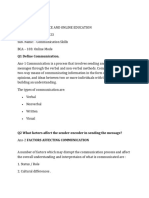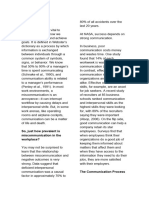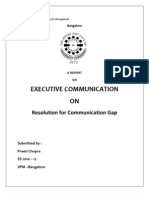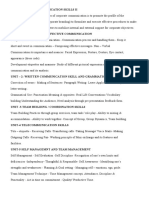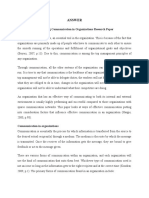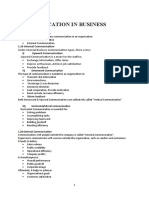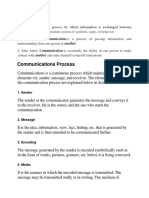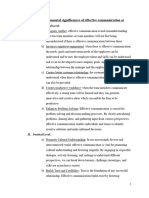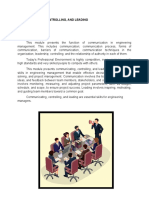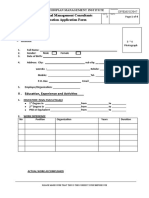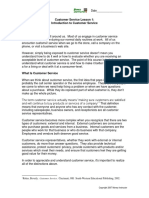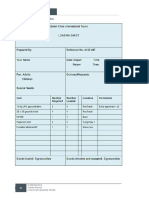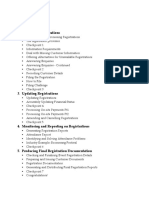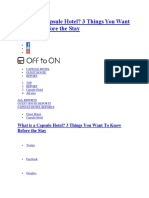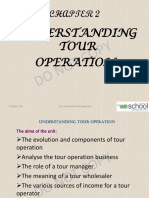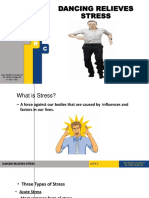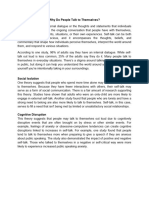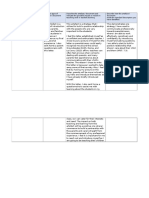Question #1: - Write at least 4 elements of workplace communication.
Elements of Workplace Communication:
Even the use of the most sophisticated technology cannot guarantee effective workplace
communication. The world is changing rather fast and the communicator has to keep
pace with the change. However, there are certain elements in all effective workplace
communication and to communicate effectively these attributes are to be taken care of.
The elements of effective workplace communication are discussed as follows:
1. Clarity of Thought and Expression:
The communicator must first know what he/she wants to convey and why. It is very
much essential that he/she understands the purpose of his message. Communication
without a clear objective amounts to groping in darkness like the seven blind men
arguing the size of the elephant. The message should be clear in order to solicit effective
feedback. Effective workplace communication begins when someone thinks clearly. You
should know what you want to communicate. And the better you know it, the more
clearly you can communicate it. Clarity of thought and expression is central to effective
workplace communication. If you cannot think clearly; you cannot express yourself
clearly. Never think communication is spontaneous; you have to make it happen. The
major mistake in communication is to believe that is happens.
2. Correctness / Appropriateness:
The message should not only be candid and clear, it should also be correct. It should be
correct in spelling, grammar, content and format. Be sure that the statistical data, if you
are using any, is correct. Use specific facts and figures. Ensure that the rules and
conventions of spelling, grammar, punctuation, usage, and idiom are correctly used as
also style (appropriateness of word choice and level of formality to audience, purpose,
and material). Rules of grammar and syntax (and punctuation) are to be followed to avoid
ambiguity. Check if social and cultural appropriateness have been maintained. Make sure
that the timing and choice of medium are appropriate to the purpose, audience, and
material. But technology cannot guarantee that you will make an effective communicator.
Dr. Laurence J. Peter humorously remarks: “The advantage of modern means of
communication is they enable you to worry about things in the entire world.” It is
worrying over a correct medium.
1
�3. Conciseness:
The message should be concise: it should give only the information that is necessary and
important, using as few words as possible but not sacrificing its completeness and clarity.
Concise messages save time, catch attention by their terseness and reduce noise. First
ensure that the material is arranged in a logical and coherent sequence and examples are
relevant, specific, detailed, sufficient and persuasive. In most of the communications,
particularly business communication, it is always advisable to come straight to the point.
4. Conducive Environment:
The environment in which a message is sent or received can also affect its meaning, shows
a research. “News stories on a general-interest news website might never appear in a
newspaper circulated in the financial community. What’s important to readers in times
of war differs from what’s important in times of natural disaster when traditional media
might not even be operating. Communicators must understand the environment in
which they are sending messages to help their audience received information in the
context in which was intended,” argues an expert.
5. Feedback:
Communication is a two-way street: it needs the efforts of both the sender and the
receiver for success. It is a complex process. The communication, in spite of all efforts,
may fail simply because the receiver somehow fails to provide feedback or the sender
fails to interpret the feedback correctly. Then, do you think communication is difficult? If
your answer is ‘yes’ you’re right. “Communication is so difficult,” asserts a guide,
because at each step in the process there is major potential of error. By the time a message
gets from a sender to a receiver, there are four basic places where transmission errors can
take place and at each place, there are a multitude of potential sources of error. Thus, it
is no surprise that social psychologists estimate that there is usually a 40-60% loss of
meaning in the transmission of messages from sender to receiver.
It is critical to understand this process, understand and be aware of the potential sources
of errors and constantly counteract these tendencies by making a conscientious effort to
make sure there is a minimal loss of meaning in your conversation. It is also very
important to understand that a majority of communication is non-verbal.” Inability to
follow feedback properly might spoil the very purpose of communication. In order to be
able to study feedbacks and responses, many factors including the language and culture
2
�of the receiver/audience are to be judged. That is why you need to be familiar with your
audience; however, it may not be possible always. But you can recognize their feelings
and anticipate reactions. The receiver also partly bears the onus of making the
communication successful through effective feedback.
6. Completeness:
Communication intends to create meaning and understanding and therefore needs to be
complete in all respects. Incomplete message breeds misunderstanding and faulty
interpretation. Even sometimes a communicator, in his/her eagerness to become concise,
adopts shortcuts. Clarity is hampered in absence of completeness. To highlight the point,
a group of communication specialists observes: “Completeness offers numerous benefits.
First, competes message is more likely to bring the desired results without the expense of
additional messages. Second, they can do a better job of building goodwill. Messages that
contain information the receiver needs show concern for others. Third, complete
messages can help avert costly lawsuits that may result if important information is
missing. Last, communications that seem inconsequential can be surprisingly important
if the information they contain is complete and effective.” So, provide all necessary and
relevant information to your receiver.
Question #2: Write at least 5 conflict resolution techniques.
In any situation involving more than one person, conflict can arise. The causes of conflict
range from philosophical differences and divergent goals to power imbalances.
Unmanaged or poorly managed conflicts generate a breakdown in trust and lost
productivity. For small businesses, where success often hinges on the cohesion of a few
people, loss of trust and productivity can signal the death of the business. With a basic
understanding of the five conflict management strategies, small business owners can
better deal with conflicts before they escalate beyond repair.
7. Accommodating (lose/win)
The accommodating strategy essentially entails giving the opposing side what it wants.
The use of accommodation often occurs when one of the parties wishes to keep the peace
or perceives the issue as minor. For example, a business that requires formal dress may
institute a "casual Friday" policy as a low-stakes means of keeping the peace with the
3
�rank and file. Employees who use accommodation as a primary conflict management
strategy, however, may keep track and develop resentment.
8. Avoiding (no winners/no losers)
The avoidance strategy seeks to put off conflict indefinitely. By delaying or ignoring the
conflict, the avoider hopes the problem resolves itself without a confrontation. Those who
actively avoid conflict frequently have low esteem or hold a position of low power. In
some circumstances, avoiding can serve as a profitable conflict management strategy,
such as after the dismissal of a popular but unproductive employee. The hiring of a more
productive replacement for the position soothes much of the conflict.
9. Collaborating (win/win)
Collaboration works by integrating ideas set out by multiple people. The object is to find
a creative solution acceptable to everyone. Collaboration, though useful, calls for a
significant time commitment not appropriate to all conflicts. For example, a business
owner should work collaboratively with the manager to establish policies, but
collaborative decision-making regarding office supplies wastes time better spent on other
activities.
10. Compromising (win some/lose some)
The compromising strategy typically calls for both sides of a conflict to give up elements
of their position in order to establish an acceptable, if not agreeable, solution. This
strategy prevails most often in conflicts where the parties hold approximately equivalent
power. Business owners frequently employ compromise during contract negotiations
with other businesses when each party stands to lose something valuable, such as a
customer or necessary service.
11. Competing (win/lose)
Competition operates as a zero-sum game, in which one side wins and other loses. Highly
assertive personalities often fall back on competition as a conflict management strategy.
The competitive strategy works best in a limited number of conflicts, such as emergency
situations. In general, business owners benefit from holding the competitive strategy in
reserve for crisis situations and decisions that generate ill-will, such as pay cuts or layoffs.



